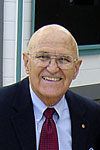




|
(San José, November 21, 2003) By Paulo Luís Ávila - Adiaspora.com
Adiaspora.com: Could you tell us about your family background and place of birth? Al Dutra: My name is Albert Silveria Dutra Jr. and I was born April 5, 1931 in New Bedford Massachussets. My father was Alberto Silva Dutra, born May 12, 1908 in New Bedford and my mother Alzira Fernandes Teixeira, born December 3, 1908 in Taunton, Mass. In 1939 or 1940 my parents moved the family to Oakland, California. I can trace my Azorean ancestry back to both sides of my family. My paternal grandparents were José Silva Dutra, born February 1, 1865 or 1866 in Feteira, on the island of Faial, Azores and Angelica da Gloria Machado Alves, born June 1871 in Lajes do Pico, Azores. They both immigrated to the United States in the same year of 1884, where they were married in New Bedford, Mass. June 2, 1887. My grandfather passed away in New Bedford in 1935 and my grandmother in 1918. My maternal grandparents were Manuel Fernandes Teixeira, born November 25, 1884 in Angra do Heroísmo on the island of Terceira, Azores and Maria de Conceiçao Marques, born in 1886 in Terra Cha, Terceira, having the latter passed away in Angra do Heroismo in 1909. My grandfather came to the United States in 1905 or 1906 and returned to the Azores around 1909. After his wife's death, Manuel returned to the US leaving the two girls (Alzira and Maria) with his parents in the Azores. Adiaspora.com: How did you learn to speak Portuguese so fluently? Al Dutra: New Bedford, where I was born, was and is a community with a strong Portuguese influence. As a result I was surrounded by the Portuguese culture when I lived there. We spoke English within the immediate family but I was also taught Portuguese. Portuguese was spoken when we were around my mother's relatives. While my Dad's father and his sisters and brothers were bilingual, I believe that English was used most often. Our parish was Mount Carmel Church, where Portuguese was used for catechism classes. When our family moved to California, we became very close to my mother's aunts and uncles. Portuguese and English were both used when the family gathered together. I learned Spanish in secondary school. Because of the similarity to Portuguese, I found the language easy to learn. At the University of California, I took one year of French but do not remember much. When I went into the Air Force I was stationed in Harlingen Texas, which is near the Mexican border, for a year. I had the opportunity to use Spanish and increased my proficiency with the language. After returning to civilian life I took a few adult education courses in Spanish but found that I had little opportunity to use the language. Starting in the 1980's I decided to take courses in Portuguese at adult education classes and at the community college in the City of Santa Clara. Since I had no prior experience in reading or writing Portuguese, I tended to use a lot of Spanish. In fact, when reading aloud from Portuguese textbooks, I had a definite Spanish accent. After my retirement from IBM I decided to become more involved with activities within the Portuguese-American community in the San Jose area. That plus the annual tours that my wife and I conducted to the Azores, Madeira and Continental Portugal gave me the opportunity to continue improving my Portuguese. Adiaspora.com: When did you become involved with the Portuguese-American Community and what positions have you come to hold within it? Al Dutra: I don't remember being involved in community activities when I lived in New Bedford. My parents didn't seem to be involved in any of the clubs or societies. When we moved to California, we became part of my mother's family circle of friends. There was a stronger connection to Portuguese-American activities. The activity that we were most involved in was attendance at the Festas do Espirito Santo (Holy Spirit Festivals). Sometime during the 1940's we became less involved. This may have been partly due to the Second World War since there was less emphasis on the Festas. In 1963, IBM transferred me to New York. The three and one half years there gave me the opportunity to visit New Bedford and visit my father's side of the family. I did not sense that they were heavily involved in Portuguese-American activities. In 1971, my daughter Lori was a side maid for a cousin who was Junior Queen for one of the Holy Ghost brotherhoods. This occurred because Ginny's sister had married a fellow of Portuguese descent and his family was involved in the society. Other than that I was not involved in any Portuguese-American activities until the 1990's. My first contact with the Portuguese-American community in San Jose was to visit the Board of Directors of POSSO, the social services organization for the community. From there I joined the Portuguese Chamber of Commerce in 1992. I became a member of the Board of Directors in 1993, Vice President in 1995 and President in 1996. Adiaspora.com: How did the idea of the Portuguese Historical Museum come about? Al Dutra: Having completed my term of office as a Director at the Chamber, I joined the Board of Directors of the Portuguese Heritage Society of California (PHSC) in 1998; I became president the following year. The PHSC established the Portuguese Historical Museum in 1997. A unique aspect of the Museum is that it is part of History Park, San Jose, a city-owned and operated park that contains historical buildings that provide a perspective of the history of the City of San Jose. (See, www.portuguesemuseum.org and www.historysanjose.org for more information.) In 1993, I joined the Luso-American Education Foundation.
The foundation is dedicated to the promotion of Portuguese Language
and Culture. For three years, I have been Vice President for Public
Relations. In addition I have served on various organizing committees
for the Dia de Portugal Celebrations in California. Currently I
am Secretary for Portuguese Heritage Publications of California
Inc. This organization is an outgrowth of the statewide research
project that resulted in the publication of the 496-page book, The
Holy Ghost Festas. Its purpose is to document and preserve
the contributions of Portuguese immigrants and their descendants
by publishing information of importance. |

